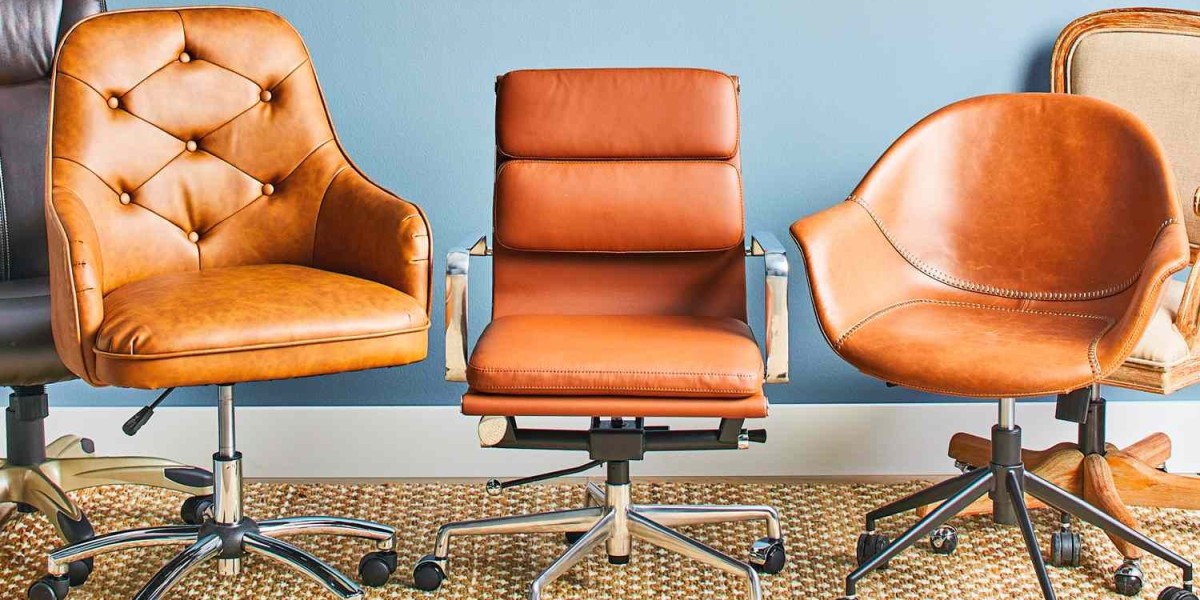When choosing between leather and fabric for an executive chair, both materials have their advantages and disadvantages depending on your preferences, office environment, and usage. Here’s a comparison to help you decide:
1. Leather Executive Chairs
Leather is often seen as the more luxurious and sophisticated option, commonly found in high-end executive offices. It has distinct characteristics that make it a popular choice.
Pros of Leather Chairs:
- Elegance and Prestige: Leather chairs exude a sense of luxury and professionalism, making a strong visual statement.
- Durability: High-quality leather is highly durable and can last for years, especially if properly cared for. It resists spills, stains, and wear better than fabric.
- Easy to Clean: Leather is much easier to wipe clean, making it ideal for office settings where spills or stains may occur.
- Classic Appeal: Leather’s timeless look suits formal executive offices, maintaining a sense of tradition and professionalism.
Cons of Leather Chairs:
- Temperature Sensitivity: Leather can be uncomfortable in extreme temperatures. It tends to feel hot and sticky in the summer and cold in the winter, which can impact comfort during long workdays.
- Cost: Leather chairs, especially those made from genuine leather, are typically more expensive than fabric options. Faux leather chairs are more affordable but don’t offer the same durability or comfort.
- Maintenance: While easy to clean, leather requires regular conditioning to maintain its softness and prevent cracking over time.
Best For:
- Executives who want a professional, luxurious look.
- Offices with controlled climates (heating and cooling).
- Individuals who prioritize durability and a classic, high-end aesthetic.
2. Fabric Executive Chairs
Fabric chairs are known for their comfort and versatility. They are available in a wide range of colors, textures, and patterns, making them a versatile option for different office styles.
Pros of Fabric Chairs:
- Breathability: Fabric chairs tend to be more breathable, keeping you cooler and more comfortable during long work sessions, especially in warmer environments.
- Comfort: Fabric can feel softer and cozier, often providing a more comfortable sitting experience, particularly for extended periods.
- Variety: Fabric chairs offer a wide range of colors, textures, and patterns, allowing you to customize the chair to fit the aesthetic of your office.
- Affordability: Fabric chairs tend to be more budget-friendly compared to genuine leather options.
Cons of Fabric Chairs:
- Staining: Fabric is more prone to stains, spills, and absorbing odors, especially in a busy office setting.
- Maintenance: It can be harder to clean and maintain, requiring regular vacuuming and spot-cleaning to remove dirt and debris.
- Durability: Fabric wears out faster than leather, showing signs of wear, fading, and pilling over time, especially with heavy use.
Best For:
- Executives seeking comfort over luxury.
- Offices in warmer climates or environments without strict temperature control.
- Individuals looking for a more casual, approachable aesthetic with a wide range of design choices.
3. Faux Leather Executive Chairs
For those who want the look of leather without the higher price or some of the maintenance issues, faux leather is an option.
Pros of Faux Leather:
- Affordability: Less expensive than genuine leather while still offering a similar appearance.
- Easy to Clean: Like real leather, faux leather is easy to wipe clean.
- Eco-friendly Options: Some faux leathers are more environmentally friendly compared to animal-derived leather.
Cons of Faux Leather:
- Less Durability: Faux leather is prone to cracking, peeling, or wearing out faster than real leather.
- Less Comfort: It doesn't have the same softness or natural breathability as genuine leather, leading to discomfort in temperature extremes.
Best For:
- Executives who want a leather look at a lower price point.
- Individuals who prefer eco-friendly or animal-friendly materials.
4. Mesh/Fabric Hybrid Chairs
If you want the breathability of fabric and the support of a structured material, mesh-backed chairs with fabric seating offer a hybrid solution.
Pros of Mesh/Fabric Hybrid:
- Breathability: Mesh backrests allow for better airflow, making these chairs ideal for warmer climates or for long periods of sitting.
- Ergonomic Support: Many mesh chairs focus on ergonomic design, providing great lumbar and back support.
Cons of Mesh/Fabric Hybrid:
- Aesthetic Limitations: Mesh may not have the same prestigious look as leather or high-end fabric chairs.
- Comfort: Mesh isn’t as soft or cushioned as fabric or leather, which can reduce comfort over long durations.
Best For:
- Executives looking for ergonomic functionality with moderate comfort and breathability.
- Offices with a focus on health and productivity rather than luxury.
Key Considerations for Choosing the Right Material:
- Aesthetic: If you're after a classic, formal look, leather is the best choice. For a more modern, comfortable feel, fabric or mesh may be a better option.
- Climate: If your office tends to be warm, fabric or mesh will keep you cooler. Leather works better in temperature-controlled environments.
- Usage: If you expect heavy use or long hours of sitting, leather may last longer and be easier to maintain. Fabric can offer more comfort for shorter workdays or less formal settings.
- Budget: Fabric chairs are generally more affordable, while leather offers prestige and durability, but at a higher cost.
Ultimately, your choice between leather and fabric should reflect your style preferences, comfort needs, and office environment.








